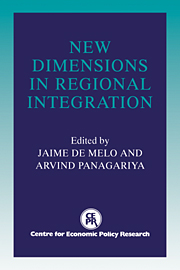Book contents
- Frontmatter
- Contents
- List of figures
- List of tables
- Preface
- Foreword
- Acknowledgements
- List of conference participants
- PART ONE SYSTEMIC ISSUES
- PART TWO COUNTRY ISSUES
- 6 The new regionalism: a country perspective
- Discussion
- 7 The European Community: a case of successful integration?
- Discussion
- 8 Regional integration in Sub-Saharan Africa: past experience and future prospects
- Discussion
- 9 Latin America's integration and the multilateral trading system
- Discussion
- 10 Regional integration in Eastern Europe: prospects for integration within the region and with the European Community
- Discussion
- 11 Regional trade arrangements in North America: CUSTA and NAFTA
- Discussion
- 12 Trading blocs and East Asia
- Discussion
- 13 Prospects for regional integration in the Middle East
- Discussion
- Round Table Discussion
- Index
7 - The European Community: a case of successful integration?
Published online by Cambridge University Press: 04 May 2010
- Frontmatter
- Contents
- List of figures
- List of tables
- Preface
- Foreword
- Acknowledgements
- List of conference participants
- PART ONE SYSTEMIC ISSUES
- PART TWO COUNTRY ISSUES
- 6 The new regionalism: a country perspective
- Discussion
- 7 The European Community: a case of successful integration?
- Discussion
- 8 Regional integration in Sub-Saharan Africa: past experience and future prospects
- Discussion
- 9 Latin America's integration and the multilateral trading system
- Discussion
- 10 Regional integration in Eastern Europe: prospects for integration within the region and with the European Community
- Discussion
- 11 Regional trade arrangements in North America: CUSTA and NAFTA
- Discussion
- 12 Trading blocs and East Asia
- Discussion
- 13 Prospects for regional integration in the Middle East
- Discussion
- Round Table Discussion
- Index
Summary
Introduction
In a volume such as this, the European Communities are taken as something of an exemplar. This chapter asks what light their experience of economic integration sheds on the organisation of other integration schemes, and on the process of integration in general. Section 2 ponders the success of the Community. That it has survived, expanded and deepened, and that its members have experienced great improvements in material well-being since its foundation, are obvious, and so it has clearly had a good measure of success. I argue, however, that questions about EC economic performance must at least be raised before taking it as the model for future integration: its macroeconomic performance has been mixed; it has, in some regards, turned in on itself; and it has fallen behind comparable countries technologically.
Section 3 notes that while the extension of trade preferences to nonmember countries has reduced some trade barriers, it has done so in ways that sometimes reduce the beneficial effects of liberalism, and which have permitted the Community to slow down its integration with the rest of the world. I also argue that while enlargement – the admission of new full members – has reduced world protectionism, even it has an element of ‘managed liberalism’ about it, which reduces somewhat the competitive benefits of market opening. Section 4 considers how other policies have contributed to integration Community-style; one set of policies – the so-called ‘four freedoms’ (of movement for labour, firms, services and capital) – aims to extend the customs union (CU) into a common market.
- Type
- Chapter
- Information
- New Dimensions in Regional Integration , pp. 202 - 228Publisher: Cambridge University PressPrint publication year: 1993
- 11
- Cited by



